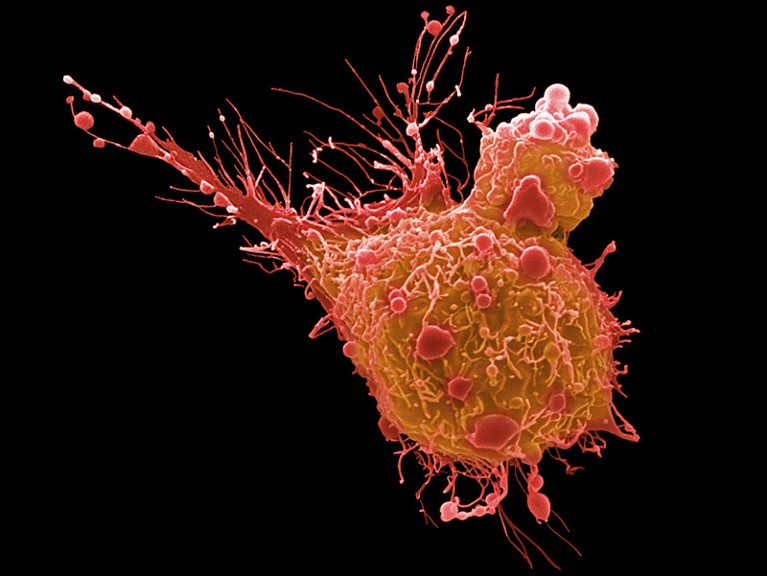Cancer trial results show power of weaponized antibodies
Cancer trial results show power of weaponized antibodies Nature.com


Advancements in Cancer Treatment: Antibody-Drug Conjugates Show Promise
A cell from a bladder tumour. Advanced bladder cancer is difficult to treat.Credit: Steve Gschmeissner/Science Photo Library

It’s rare to get a standing ovation at a scientific conference. But on 22 October, cancer researcher Thomas Powles received two.
The first came in the middle of his talk, after he announced that a combination of treatments cut the risk of death in people with advanced bladder cancer by more than half — an unprecedented result in a cancer for which survival rates have been almost unchanged since the 1980s.
Introduction
Powles, who works at St Bartholomew’s Hospital in London, says he was surprised by the response, and stumbled through to the end of his presentation, at which point he was met with another ovation. “People were just glad that I finished.”
Powles was not the only person to present promising data for a class of cancer treatments called antibody–drug conjugates (ADCs) at the European Society for Medical Oncology Congress, held in Madrid on 20–24 October. Further data from trials in breast cancer and other types of tumour added to the momentum of the technology, which uses cancer-targeting antibodies to deliver toxic agents to tumours.
Potent Mixture
The combination of drugs used in the bladder cancer study was approved by the US Food and Drug Administration earlier this year. But the data underlying that approval came from a trial of only about 120 people who received the two drugs — the ADC enfortumab vedotin (marketed as Padcev) with pembrolizumab (Keytruda) — so it was unclear how the treatment would perform in a larger trial, says Powles.
Pembrolizumab blocks a protein that hinders the immune system, allowing the body to launch a more effective attack against tumours. Enfortumab vedotin consists of an antibody that targets a protein called nectin-4, which is expressed at higher levels in some types of cancer cell than in non-cancerous cells. Attached to this antibody is a chemical that disrupts cell division.
Implications and Further Trials
The aim of ADCs such as enfortumab vedotin is to provide a way to deliver chemotherapies that target dividing cells directly to tumours, rather than administering them throughout the body, where they can damage other tissues. Several ADCs are already marketed against various forms of cancer, but researchers are still working to find the best way to design them and put them to use in the clinic.
In Madrid, Powles reported that his team’s drug cocktail nearly doubled the median length of time that people with advanced bladder cancer survived after their treatment, from about 16 months to 31.5 months, compared with conventional chemotherapy. The study tracked more than 880 people who had been randomly assigned to one of the two treatments.
Such large benefits are rarely seen in cancer research, where months of added survival are often celebrated as a breakthrough. That’s true especially of advanced bladder cancer, for which decades of research had consistently failed to improve survival times substantially. “We kind of knocked it out of the park,” says Powles.
The implications of these promising results extend beyond bladder cancer, says Lillian Siu, a cancer researcher at Princess Margaret Cancer Centre in Toronto, Canada, because it suggests that ADCs might become more potent when combined with an immune-boosting drug such as pembrolizumab. Trials of other conjugates in other cancers are likely to proliferate, agrees Powles: “It’s going to launch a thousand ships.”
Other results presented at the meeting are poised to expand the use of ADCs in advanced breast cancer, says Meric-Bernstam. One group reported that an ADC called datopotamab deruxtecan slowed tumour growth, with recipients lasting two months longer than those who received conventional chemotherapy before their tumours started to expand again. Another showed that an ADC called trastuzumab deruxtecan, which targets the tumour protein HER2, improved survival in people with advanced breast cancer — even those whose tumours produced low levels of HER2.
Each of these successes could help the treatments to reach more people, says Meric-Bernstam. She adds that shifting the use of the drugs to earlier stages of cancer could boost their efficacy further.
Although ADCs were developed in the hope of creating a safer form of chemotherapy, they have proved to pose risks of their own, including the potential for nerve and lung damage. Future research should focus on developing even less toxic ADCs, says Siu, as well as investigating which drugs can be used together safely.
“There are a lot of questions to answer,” she says. “It’s a whole new class of drug that we can use. We have to really think about how to use it.”
SDGs, Targets, and Indicators
-
SDG 3: Good Health and Well-being
- Target 3.4: By 2030, reduce by one-third premature mortality from non-communicable diseases through prevention and treatment and promote mental health and well-being.
- Indicator: Risk of death in people with advanced bladder cancer reduced by more than half.
-
SDG 9: Industry, Innovation, and Infrastructure
- Target 9.5: Enhance scientific research, upgrade the technological capabilities of industrial sectors in all countries, in particular developing countries, including, by 2030, encouraging innovation and substantially increasing the number of research and development workers per 1 million people and public and private research and development spending.
- Indicator: Promising data for antibody-drug conjugates (ADCs) presented at the European Society for Medical Oncology Congress.
-
SDG 17: Partnerships for the Goals
- Target 17.16: Enhance the global partnership for sustainable development, complemented by multi-stakeholder partnerships that mobilize and share knowledge, expertise, technology, and financial resources to support the achievement of the sustainable development goals in all countries, in particular developing countries.
- Indicator: Collaboration between researchers, hospitals, and pharmaceutical companies to develop and test new cancer treatments.
| SDGs | Targets | Indicators |
|---|---|---|
| SDG 3: Good Health and Well-being | Target 3.4: By 2030, reduce by one-third premature mortality from non-communicable diseases through prevention and treatment and promote mental health and well-being. | Risk of death in people with advanced bladder cancer reduced by more than half. |
| SDG 9: Industry, Innovation, and Infrastructure | Target 9.5: Enhance scientific research, upgrade the technological capabilities of industrial sectors in all countries, in particular developing countries, including, by 2030, encouraging innovation and substantially increasing the number of research and development workers per 1 million people and public and private research and development spending. | Promising data for antibody-drug conjugates (ADCs) presented at the European Society for Medical Oncology Congress. |
| SDG 17: Partnerships for the Goals | Target 17.16: Enhance the global partnership for sustainable development, complemented by multi-stakeholder partnerships that mobilize and share knowledge, expertise, technology, and financial resources to support the achievement of the sustainable development goals in all countries, in particular developing countries. | Collaboration between researchers, hospitals, and pharmaceutical companies to develop and test new cancer treatments. |
Behold! This splendid article springs forth from the wellspring of knowledge, shaped by a wondrous proprietary AI technology that delved into a vast ocean of data, illuminating the path towards the Sustainable Development Goals. Remember that all rights are reserved by SDG Investors LLC, empowering us to champion progress together.
Source: nature.com

Join us, as fellow seekers of change, on a transformative journey at https://sdgtalks.ai/welcome, where you can become a member and actively contribute to shaping a brighter future.







